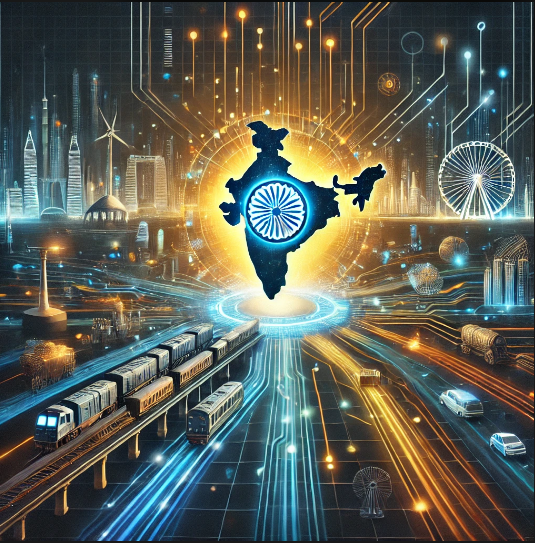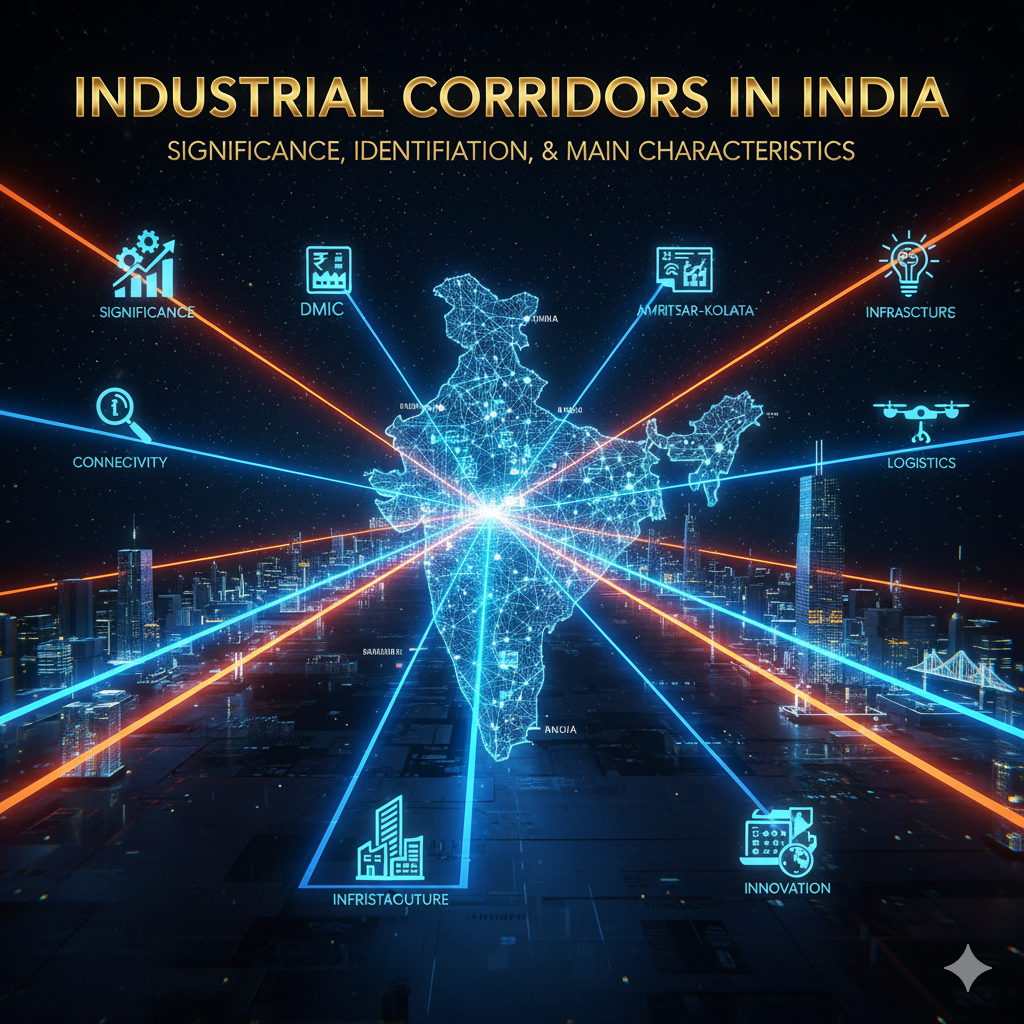Introduction
Infrastructure development plays a critical role in a country’s economic growth and global competitiveness. India, with its vast geography and diverse industrial landscape, faces challenges related to inefficient logistics, inadequate connectivity, and delays in project execution. To address these issues, the Government of India launched the PM Gati Shakti National Master Plan on October 13, 2021.
This ambitious initiative aims to provide multi-modal connectivity and integrated infrastructure planning across various sectors, ensuring faster and more efficient movement of goods, people, and services. By leveraging technology, data analytics, and inter-ministerial coordination, the plan seeks to reduce logistical costs, promote economic growth, and enhance India’s position as a global manufacturing hub.
This article explores the key pillars of PM Gati Shakti Yojana, its impact on competitiveness and connectivity, and the challenges and opportunities in its implementation.
Key Pillars of PM Gati Shakti Yojana
The PM Gati Shakti initiative is built on six fundamental pillars, each designed to address specific challenges in India’s infrastructure and logistics ecosystem.
1. Comprehensiveness
- The plan integrates data from multiple ministries, states, and government agencies to provide a holistic view of India’s infrastructure projects.
- It combines information on roads, railways, ports, airports, waterways, and urban infrastructure, ensuring that development efforts are well-coordinated.
- This single digital platform eliminates duplication of efforts and allows real-time monitoring of project progress.
2. Prioritization
- The initiative ensures that critical infrastructure projects are identified and executed on priority.
- It uses geospatial technology and big data analytics to determine the most important projects that can have the maximum economic impact.
- This helps in efficient resource allocation and faster completion of high-impact projects.
3. Optimization
- PM Gati Shakti focuses on the optimal utilization of existing infrastructure and resources.
- The initiative ensures that new infrastructure projects complement existing assets rather than duplicate efforts.
- By integrating railways, highways, and waterways, the plan reduces bottlenecks and creates a seamless transportation network.
4. Synchronization
- One of the biggest challenges in India’s infrastructure sector is the lack of coordination between different government agencies.
- PM Gati Shakti ensures that multiple ministries work in synchronization, reducing delays and conflicts.
- Ministries such as Railways, Road Transport, Civil Aviation, Shipping, Petroleum, and Telecom are integrated into a unified decision-making framework.
5. Analytical Approach
- The initiative employs advanced technology, including GIS-based planning tools, satellite imagery, and AI-driven data analytics, to enhance decision-making.
- The use of real-time data allows for better tracking of projects, identifying bottlenecks, and improving logistics efficiency.
- This data-driven approach ensures evidence-based policy decisions, leading to cost-effective and time-bound execution.
6. Dynamic Approach
- Unlike traditional planning models, PM Gati Shakti follows a dynamic and flexible strategy.
- Infrastructure projects are continuously updated and modified based on changing economic trends, demand fluctuations, and emerging challenges.
- This ensures that India’s infrastructure remains future-ready and adaptable to evolving global trade dynamics.
Will PM Gati Shakti Improve Competitiveness and Connectivity?
The PM Gati Shakti Yojana is expected to revolutionize infrastructure development in India by enhancing connectivity and improving logistics efficiency. Here’s how it contributes to competitiveness and connectivity:
1. Boosting Economic Competitiveness
- Lower Logistics Costs: India’s logistics cost is currently around 13-14% of GDP, compared to 8-10% in developed countries. Gati Shakti aims to reduce logistics costs, making Indian products more competitive in global markets.
- Attracting Foreign Investment: Improved infrastructure attracts foreign direct investment (FDI) in manufacturing, exports, and supply chain industries.
- Enhancing Ease of Doing Business: Efficient transportation networks and reduced red tape contribute to a better business environment, boosting industrial productivity.
2. Strengthening Multi-Modal Connectivity
- Seamless Integration of Transport Modes: Gati Shakti ensures better connectivity between railways, highways, ports, and airports, allowing businesses to transport goods faster and at lower costs.
- Faster Movement of Goods: Reduced transit time and better logistics management improve supply chain efficiency.
- Enhanced Rural-Urban Linkages: Improved road and rail networks strengthen connectivity between rural areas and urban economic centers, boosting local economies.
3. Infrastructure Development Across Sectors
- Railways: 100+ key railway projects are being implemented to improve freight movement.
- Highways: The construction of expressways and industrial corridors ensures better road connectivity.
- Ports & Waterways: Enhanced port infrastructure reduces congestion, boosting exports and maritime trade.
- Airports: Expansion of regional airports under UDAN (Ude Desh Ka Aam Nagrik) Scheme ensures better air connectivity.
- Telecom & Digital Connectivity: Expansion of fiber-optic networks ensures faster digital connectivity across the country.
4. Promoting Industrial Growth and Job Creation
- PM Gati Shakti will strengthen industrial corridors, economic zones, and special manufacturing clusters, creating new job opportunities.
- Smoother logistics and better transportation networks will enable small and medium enterprises (SMEs) and startups to expand their operations.
- The initiative supports Make in India and Atmanirbhar Bharat, boosting domestic manufacturing.
5. Strengthening National Security and Disaster Management
- Better border connectivity will enhance security infrastructure in strategic areas such as Ladakh, Arunachal Pradesh, and the Northeast.
- Improved infrastructure helps in disaster relief and emergency response, ensuring quick mobilization of resources during natural calamities.
Challenges in Implementing PM Gati Shakti
Despite its potential, the implementation of PM Gati Shakti faces several challenges:
- Coordination Between Ministries and States – Ensuring seamless collaboration among different stakeholders remains a challenge.
- Land Acquisition Issues – Infrastructure projects often face delays due to land acquisition disputes.
- High Initial Investment – The scale of the project requires significant capital investment and financial sustainability.
- Bureaucratic Delays – Streamlining approvals and reducing red tape is essential for smooth execution.
- Technology Adoption – Effective use of AI, GIS, and data analytics needs skilled manpower and robust IT infrastructure.
Future of PM Gati Shakti and Its Long-Term Impact
The success of PM Gati Shakti will depend on efficient execution, inter-ministerial coordination, and private sector participation. In the coming years, we can expect:
- Expansion of Smart Cities – Integrated infrastructure planning will boost the development of smart urban areas.
- Growth of Logistics Hubs – New multi-modal logistics parks will enhance supply chain efficiency.
- Sustainable Infrastructure – Adoption of green energy, EV charging stations, and eco-friendly transport solutions.
- Global Trade Expansion – Improved connectivity will strengthen India’s role in international trade and exports.
Conclusion
PM Gati Shakti Yojana is a game-changer for India’s infrastructure landscape, ensuring faster, cost-effective, and technology-driven development. By integrating multi-modal transport networks, improving logistics efficiency, and enhancing industrial competitiveness, the initiative will position India as a global economic powerhouse.
While challenges remain, proactive governance, digital transformation, and private sector involvement will be key to its success. If implemented effectively, PM Gati Shakti has the potential to reshape India’s infrastructure, boost economic growth, and create a globally competitive ecosystem for trade and commerce.
With a visionary approach and strategic execution, PM Gati Shakti will not only strengthen connectivity but also drive long-term sustainable development, making India a leader in infrastructure innovation and global trade.




